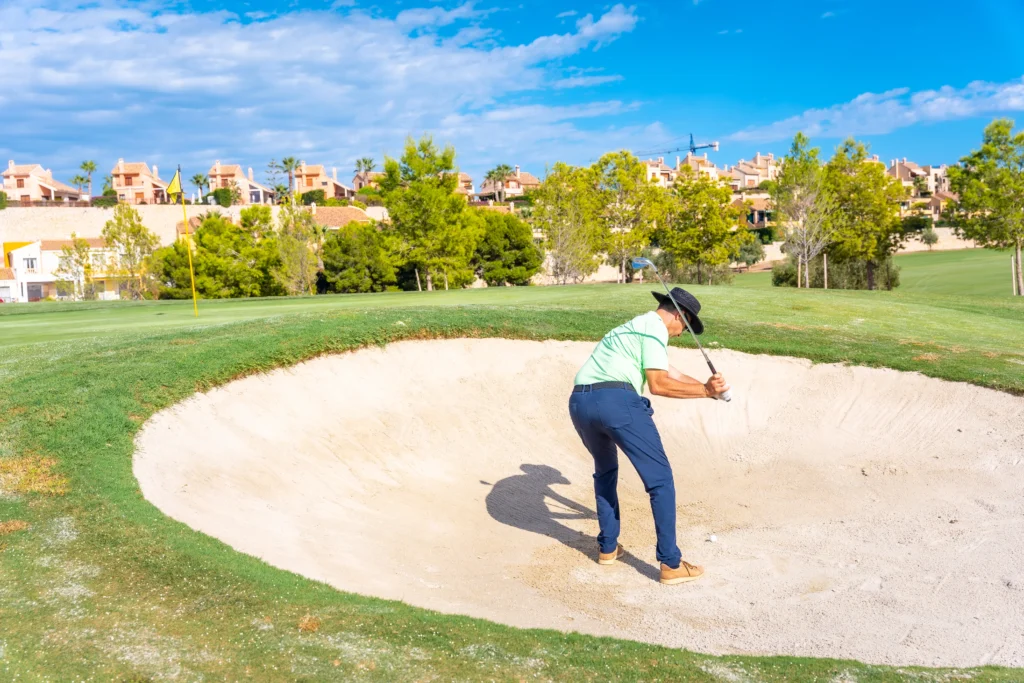
Golf bunker attempts may be hard for newbies, but getting a sand shot try is effortless when one applies the right golf techniques.
Effectively, the key tip that will increase the chances of success is to make contact with the exposed sand before the ball, so that it can be free of the bunker. A correct stance, grip, and centre of mass will influence the outcome of the shot.
A golfer executing a sand bunker shot during the day with clear blue sky, vibrant green fairways laden with flowers, and a flagstick at the back.
Sand wedge golf bunker shots take a look at the body, the body position, as well as the club, which are crucial.
The golfers are better off putting their dominant hand on the underpart of the grip, bending their knees and shifting the body weight to the front foot. This position enables the golfer to control the club through the sand, which exposes instead of digging, resulting in delicate and stuck shots.
Through striking uncomplicated drills and having a keen focus on the fundamentals, newcomers can build self-assurance when confronting a bunker for the first time.
Knowing these fundamentals, understanding various bunker lies and enhancing performance. You can find more advice along with additional tips in the golfer’s guide towards bunker shots.
Fundamentals of Bunker Shots
Understanding the golf bunker shot
Bunkers are hazards usually made of sand, which are placed to test players’ skills. Unlike normal turf, sand has a different texture, which affects the interaction with the club and the ball.
For example, the ball should ideally be sandwiched between the club and the sand so that it is trapped in the golf club.
All types of sand come in different depths, textures and loose particles, which determine how deep a player must “dig”.
Different textures of sand, like soft sand, cause the club to go deeper, whereas firm sand does not require as much thrust. Knowing what type of bunker a player is dealing with is essential for choosing a proper club and technique.
It is also crucial to concentrate on the lip of the bunker. In case the lip is high, a swing with more height and a highly lofted club is needed to propel the ball high as soon as possible.
Understanding all of these components will enable any novice to hit effective bunker shots.
Fundamentals of Bunker Shot Technique
The proper setup before the shot is very important. The player should open the clubface slightly to add loft. This approach assists the club in sliding through the sand instead of digging in.
Feet should be placed supremely and wider than the normal stance to maintain balance during the shot’s follow-through.
Weight is generally kept on the lead foot to ensure the player strikes downward.
The shoulders and hips should be slightly level forward in the stance and ensuring the action puts the sand wedge within striking distance of the ball.
The knees are bent more than usual, which ensures that the range of movement does not compromise upper body stability. Keeping the sternum behind the ball prevents the player from striking the golf club before the sand.
Typical Challenges for Beginners
Beginners often struggle with where to hit the ball in the sand. Many try to strike the ball directly instead of focusing on the sand just behind it. This leads to poor contact or the ball staying in the bunker.
Another common issue is closing the clubface instead of opening it. This reduces loft, causing the ball to roll out too far or get stuck.
Balance is also tricky. Shifting weight incorrectly or standing too narrow can cause slipping or poor swings. Finally, fear of the bunker may cause a tentative swing rather than the aggressive strike needed for success.
Core Techniques for Successful Bunker Shots
How to Hit a Bunker Shot
For a successful execution of a bunker shot, one should concentrate on striking the sand before the ball.
The clubface should be opened slightly to enhance loft, which allows the ball to pop out gently. The feet should take a firm stance to allow for grip on the ground and prevent slipping when swinging.
An effective bunker shot is achieved by putting the ball a bit further ahead in the stance and setting the body parallel to the line where the club should approach the ball, which is outside and forward of the target line.
The player’s weight should be very much directed to the front foot for the duration of the swing to maintain the desired control of the shot direction and elevation.
Optimising Your Golf Swing in the Sand
In the sand, the golf swing differs from a regular shot. The backswing should be smooth and controlled to maintain balance. Avoid trying to hit the ball directly; instead, focus on swinging through the sand.
Hands should remain ahead of the clubhead at impact to ensure the club strikes the sand first. The follow-through should be full and relaxed to help send the ball out with the right trajectory. Practising this swing helps improve consistency when hitting sand shots.
Effective Sand Blasting and Ball Centring Techniques
Fulfilling the ball striking technique in bunkers requires striking a specific spot just an inch and a half before the ball.
The club should enter the sand one to two inches away from the ball. This makes sure the sand can easily remove the ball.
| Key Points for Sand Contact | Explanation |
|---|---|
| The club enters the sand behind the ball | Ensures the sand carries the ball out |
| Open clubface position | Increases loft and soft landing |
| Weight forward | Keeps the club stable and on track |
| Accelerated swing through contact | Controls distance and trajectory |
Common Bunker Shot Mistakes to Avoid
Novice players often try to hit the ball with too much force, which gets the club head stuck in the sand too deeply. Such moves are known as short or fat shots. Another mistake is having an overly erect or overly leaned-back posture. Both of these reduce power and the amount of control the player has
Not opening the clubface or swinging with too much force leads to poor strikes, loss of contact with the ball, and inaccuracy of the shot.
Bouncing the club on the sand during setup also leads to erratic strikes and poor accuracy. Persistent correct border technique helps to reduce such errors when hitting out of a sand trap.
Players should not look up too soon after the shot as they will lose balance striking the ball and affect their smooth through.
Practical Bunker Shot Tips for Beginners

Smart Club and Ball Selection
Most novices ought to utilize a sand wedge for bunker shots. It has a broad sole that is meant to skim the sand and lift the ball out cleanly.
For longer distances, a lob wedge or gap wedge could be more appropriate, but for most bunker shots, the sand wedge is the go-to club.
The choice of ga golf ball also plays an important role. Golf balls that are softer and have good spin control enable the ball to stop dead on the green after landing.
This is beneficial for novices who desire more control over the landing spot of their bunker shot.
Key points for smart selection:
Use a sand wedge for most bunker shots
Try lob or gap wedges for longer shots
Pick a softer golf ball designed for control
This combination helps beginners focus on learning bunker technique without worrying about unsuitable clubs or balls.
Adjusting For Dressing Differences: Sand And Lies
A sand’s coarseness has an impact on the ball’s movement. The displaced sand’s density had compacted. As a result, it may require a specific method to achieve different results.
Soft sand requires more club acceleration deeper underneath the sand volume, with the idea to be moved for the ball is moved upwards.
On the other hand, hard sand requires calculative circulation that doesn’t reserve too much space to avoid being out of the target region.
What position of the ball impacts the outcome as well. When the ball is positioned deeper into the sand, the head has to slope more to allow the face to swing at a steep angle and then be set free.
Improving and Advancing Your Bunker Game

Practice Drills for Bunker Proficiency
With practice, any golfer can improve bunker shots. One significant practice is concentrating on striking the sand a few inches behind the ball. To increase the chances of lifting the ball out smoothly, this is better than hitting the ball directly.
Also, a player can be asked to throw sand onto the green for perfect concentration on sand shots with no ball.
This strengthens the control of swing speed and motion for softer and more precise shots from the bunker.
Bunker Shot Strategies for On-Course Play
While dealing with bunker shots on the course, proper setup along with good strategy makes a great difference.
The player’s ball position to the stance should be slightly forward, and the clubface should be open. This assists with getting under the ball to ease it out and lift it softly.
It is indeed important to maintain movement during a swing that is smooth and committed.
Any kind of hesitation or decrease in acceleration tends to result in poor impact. Exploding the sand before topping the ball is what needs to be accomplished.
Frequently Asked Questions
What are the basic approaches for executing bunker shots for novice players?
Beginners should focus on striking the sand approximately 1-2 inches behind the ball. This technique enhances the chances of cleanly getting the ball out of the bunker.
A wider stance allows for improved stability, and keeping the lower body steady reduces unnecessary movement during the shot.
What options do seniors have for executing effective bunker shots?
Seniors are advised to swing softer to keep control and avoid overswinging. Using a sand wedge with a higher bounce helps prevent excessive digging into the sand.
Correct body alignment, with the ball placed just inside the front heel of the lead foot, assists in forming the proper angle of attack.
How does one escape from a greenside bunker with the least strokes possible?
Stepping out of the bunker consistently requires focusing on a spot a couple of inches behind the ball instead of the ball itself. This encourages the club to slide under the sand and effortlessly lift the ball onto the green.
What is the optimal stance and foot placement during a bunker shot?
Stability is aided with a stance wider than the norm. The feet should be carved into the sand to a selected depth for additional control and strength.
Usually, the ball position is a bit forward, nearer to the front heel, which aids in hitting under the ball in a clean manner.
Should grip length be altered when attempting shots from the bunker?
Most players will grip give the club a slight choke for better control of the lower portion of the grip. This aids in increasing shot accuracy and decreasing the club’s rate of torque at impact.
These golfers maintain good posture; however, the pivot requires a free motion.
What methods accomplish the best sought consequences for tackling the issue of performance on short bunker shots?
Succeeding in the sand enables self-assurance in varying conditions. Hitting behind the ball with different distances achieves improved contact and height.




